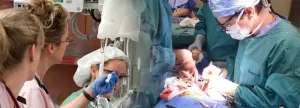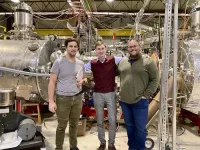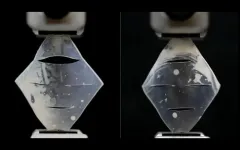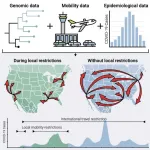(Press-News.org) In an effort to better optimize the triage of patients during mass casualty events, University of Maryland School of Medicine (UMSOM) researchers are receiving up to $7.3 million in funding from the Defense Advanced Research Project Agency (DARPA) for vital new research. The funding will be used to support a study that will collect data over the next 3.5 years on trauma patients with the aim of identifying and implementing lifesaving advancements in medical triage for large-scale mass casualty incidents.
“The importance of early interventions in trauma is described as the concept of the ‘golden hour’, which means the first hour of trauma care is very important,” said study Principal Investigator Peter Hu, PhD, Professor of Anesthesiology at UMSOM and Chief Technologist at the R Adams Cowley Shock Trauma Center at the University of Maryland Medical Center (UMMC). “When disasters happen, if we can use machine learning to rapidly predict the need for lifesaving interventions, we can be more effective in triage – especially in situations where medical personnel are limited.”
DARPA’s Research Infrastructure for Trauma with Medical Observations (RITMO) effort, which is funding the study, aims to create a single database of de-identified trauma patient data derived from the early post-injury period. The RITMO program is the foundational data component of the DARPA Triage Challenge, a 3.5-year challenge designed to drive the development of physiological ‘signatures’ of injury that will help medical responders quickly assess patient vital signs, make triage decisions and render aid to the critically injured in military and civilian mass casualty incidents. Mass casualty incidents involve multiple injured patients and can include large-scale traffic accidents, natural disasters like hurricanes or wildfires, or violent attacks like mass shootings.
“As a member of our armed forces, I am proud to see our faculty collaborate on the development of this cutting-edge technology in trauma triage,” said Col. Samuel Galvagno, DO, PhD, MS, MBA, FCCM Professor and Interim Chair of the Department of Anesthesiology at UMSOM, Interim Chief of Anesthesiology at UMMC and a General Officer in the United States Air Force Reserve. “This work extends beyond military combat and will universally transform how we approach trauma care.”
The UMSOM team will collect de-identified data on trauma patients ages 18 to 65 who are admitted to the R Adams Cowley Shock Trauma Center over the next three years. Data collected will include continuous patient vital signs and lifesaving medical intervention data through each stage of trauma triage including field care, helicopter transport, trauma center reception, and resuscitation and stabilization. The UMSOM team will also contribute additional indicators of patient status such as brain and tissue oxygen readings to help identify potential neurological injuries.
“With minute-by-minute patient data, we can have a clearer picture of where a patient is deteriorating and prepare our trauma teams with critical answers such as how much blood may be needed upon arrival,” said Thomas Scalea, MD, The Honorable Francis X. Kelly Distinguished Professor of Trauma Surgery at UMSOM, Director of the Program in Trauma, and Physician-in-Chief of the Shock Trauma Center. “Being able to obtain real-time insights before patients reach the trauma center is pivotal in the advancement of the triage process.”
Findings from this new study will also be used in a separate RITMO initiative called the DARPA Triage Challenge data competition. Teams in the data competition are challenged to develop algorithms that will detect the signatures of injury through non-invasive sensors. This will provide insights that will enable accuracy in triage decision-making such as prioritization for medical evacuation.
As part of the DARPA Triage Challenge, a University of Maryland College Park robotics team is working on building drones with stand-off sensors that will utilize the algorithms to drive the aerial assessment of vitals and injuries in real-time. Sarah Murthi, MD, Professor of Surgery at UMSOM and a critical care surgeon at the Shock Trauma Center, is part of this team and will contribute her expertise on medical sensing and triage procedures.
“The number of U.S. shootings with multiple victims has nearly doubled over the past five years to more than 600 shootings per year, which underscores the dire need to advance new triage technologies,” said Mark T. Gladwin, MD, the John Z. and Akiko K. Bowers Distinguished Professor and Dean, UMSOM, and Vice President for Medical Affairs, University of Maryland, Baltimore. “Combining high-resolution physiological data with machine-learning tools will ultimately yield a new form of precision medicine in critical care to better assess a trauma patients’ immediate needs with the ultimate aim of saving lives.”
Over the past 10 years, Dr. Hu and his colleagues have received $35 million in grant funding to contribute data and aid the development of lifesaving interventions in trauma. He is also working on other research to predict the early need for blood transfusions in mass casualty incidents.
To learn more about RITMO program and the DARPA Triage Challenge visit triagechallenge.darpa.mil.
About the University of Maryland School of Medicine
Now in its third century, the University of Maryland School of Medicine was chartered in 1807 as the first public medical school in the United States. It continues today as one of the fastest growing, top-tier biomedical research enterprises in the world -- with 46 academic departments, centers, institutes, and programs, and a faculty of more than 3,000 physicians, scientists, and allied health professionals, including members of the National Academy of Medicine and the National Academy of Sciences, and a distinguished two-time winner of the Albert E. Lasker Award in Medical Research. With an operating budget of more than $1.2 billion, the School of Medicine works closely in partnership with the University of Maryland Medical Center and Medical System to provide research-intensive, academic, and clinically based care for nearly 2 million patients each year. The School of Medicine has more than $500 million in extramural funding, with most of its academic departments highly ranked among all medical schools in the nation in research funding. As one of the seven professional schools that make up the University of Maryland, Baltimore campus, the School of Medicine has a total population of nearly 9,000 faculty and staff, including 2,500 students, trainees, residents, and fellows. The School of Medicine, which ranks as the 8th highest among public medical schools in research productivity (according to the Association of American Medical Colleges profile) is an innovator in translational medicine, with 606 active patents and 52 start-up companies. In the latest U.S. News & World Report ranking of the Best Medical Schools, published in 2023, the UM School of Medicine is ranked #10 among the 92 public medical schools in the U.S., and in the top 16 percent (#32) of all 192 public and private U.S. medical schools. The School of Medicine works locally, nationally, and globally, with research and treatment facilities in 36 countries around the world. Visit medschool.umaryland.edu
About the R Adams Cowley Shock Trauma Center
The R Adams Cowley Shock Trauma Center, University of Maryland Medical Center was the first fully integrated trauma center in the world and remains at the epicenter for trauma research, patient care and teaching, both nationally and internationally today. Shock Trauma is where the "golden hour" concept of trauma was born and where many lifesaving practices in modern trauma medicine were pioneered. Shock Trauma is also at the heart of the Maryland's unparalleled Emergency Medical Service System. Learn more about Shock Trauma.
END
UM School of Medicine awarded up to $7.3M from DARPA to drive innovation in trauma triage technology, improve mass casualty response efforts
UMSOM team to provide trauma datasets to help predict the need for lifesaving interventions in real time
2023-12-15
ELSE PRESS RELEASES FROM THIS DATE:
Transportation planning goes virtual
2023-12-15
Freight transportation is a backbone of the US economy — and a significant contributor to US greenhouse gas emissions. In fact, freight accounts for nearly 10% of annual U.S. emissions,ISE Dan Doulet Faculty Fellow and Professor Xueping Li points out. Li and an interdisciplinary, multi-institutional team have been awarded funding from the US Department of Energy to launch a first-of-its-kind, national-scale undertaking to address freight’s impact on climate change — and climate change’s impact on this vital sector.
Funding from DOE’s Advanced Research Projects Agency-Energy (ARPA-E) is highly competitive. “Any ...
Zhou’s new tech has low-income housing covered
2023-12-15
When looking for ways to reduce their carbon footprint, most people think of first of their car, not their house. Surprisingly, however, buildings make up one of the largest energy-consuming sectors of the US economy, accounting for 39 percent of the country’s total energy use.
“Heating and cooling are among the most energy-intensive parts of building operations,” said Associate Professor of Civil and Environmental Engineering Nick Zhou, who leads UT’s Sustainable and Adaptive Built Environment Group in ...
New framework to identify genetic risk of disease could lead to targeted therapeutics
2023-12-15
Genome-wide association studies (GWAS) on patient blood samples are useful for identifying the genetic basis of blood cell traits and their links to common diseases. While previous experiments have focused on characterizing clinical parameters such as cell count, few have evaluated the dynamic effects of factors—such as inflammation, microbiome or medications—on blood cell contributions to disease development and progression. This lack of insight into underlying biological mechanisms behind such chronic progressive conditions has hindered ...
Newly developed material gulps down hydrogen, spits it out, protects fusion reactor walls
2023-12-14
MADISON – University of Wisconsin–Madison engineers have used a spray coating technology to produce a new workhorse material that can withstand the harsh conditions inside a fusion reactor.
The advance, detailed in a paper published recently in the journal Physica Scripta, could enable more efficient compact fusion reactors that are easier to repair and maintain.
“The fusion community is urgently looking for new manufacturing approaches to economically produce large plasma-facing components in fusion reactors,” says Mykola Ialovega, a postdoctoral researcher in nuclear engineering and engineering physics at ...
Tufts University announces Second Annual Cellular Agriculture Innovation Day
2023-12-14
Tufts University, home to the world’s largest concentration of academic researchers working on cultivated meat, will be hosting its second annual Cellular Agriculture Innovation Day on January 11, 2024. The day-long event will be held at Tufts’ Joyce Cummings Center in Medford, following a year of major developments in the industry — including regulatory approval of cultivated meat in the United States. Bringing together researchers, entrepreneurs, policymakers, and investors, Cellular Agriculture Innovation Day is an opportunity for candid ...
DOE’s Office of Science releases vision outlining the path to advancing fusion energy science and technology
2023-12-14
Washington, D.C. – The Office of Fusion Energy Sciences (FES), at the U.S. Department of Energy’s Office of Science, announced the release of its vision, Building Bridges: A Vision for the Office of Fusion Energy Sciences, during the Fusion Energy Sciences Advisory Committee hearing on December 13, 2023. This FES vision enables DOE to establish the steps needed to help advance fusion energy, including addressing key science and technology gaps in the supply chain and industry, bringing the United States one step closer to achieving net-zero emissions by 2050.
Fusion, the process that powers ...
Rubber that doesn’t grow cracks when stretched many times
2023-12-14
Researchers from the Harvard John A. Paulson School of Engineering and Applied Sciences (SEAS) have increased the fatigue threshold of particle-reinforced rubber, developing a new, multiscale approach that allows the material to bear high loads and resist crack growth over repeated use. This approach could not only increase the longevity of rubber products such as tires but also reduce the amount of pollution from rubber particles shed during use.
The research is published in Nature.
Naturally occurring rubber latex is soft and stretchy. For a range of applications, including tires, hoses, and dampeners, rubbers are reinforced by ...
Social distancing was more effective at preventing local COVID-19 transmission than international border closures
2023-12-14
LA JOLLA, CA—Elucidating human contact networks could help predict and prevent the transmission of SARS-CoV-2 and future pandemic threats. A new study from Scripps Research scientists and collaborators points to which public health protocols worked to mitigate the spread of COVID-19—and which ones didn’t.
In the study, published online in Cell on December 14, 2023, the Scripps Research-led team of scientists investigated the efficacy of different mandates—including stay-at-home measures, social distancing and travel restrictions—at preventing local and regional transmission during different phases of the COVID-19 pandemic. They found ...
Custom software speeds up, stabilizes high-profile ocean model
2023-12-14
On the beach, ocean waves provide soothing white noise. But in scientific laboratories, they play a key role in weather forecasting and climate research. Along with the atmosphere, the ocean is typically one of the largest and most computationally demanding components of Earth system models like the Department of Energy’s Energy Exascale Earth System Model, or E3SM.
Most modern ocean models focus on two categories of waves: a barotropic system, which has a fast wave propagation speed, and a baroclinic system, which ...
Can you change a chicken into a frog, a fish or a chameleon?
2023-12-14
Gastrulation is one of the most important phases in early embryonic development. Before gastrulation, vertebrate embryos are simple two-dimensional sheets of cells. By the end of gastrulation, an embryo will have begun to differentiate distinct cell types, set up the basic axes of the body and internalize some of the precursors for organs in a three-dimensional structure. Amniotes, like chickens and humans, will have developed a primitive streak, the precursor to the brain and skin, while fish and amphibians will have developed a spherical-shaped ...
LAST 30 PRESS RELEASES:
The Ceramic Society of Japan’s Oxoate Ceramics Research Association launches new international book project
Heart-brain connection: international study reveals the role of the vagus nerve in keeping the heart young
Researchers identify Rb1 as a predictive biomarker for a new therapeutic strategy in some breast cancers
Survey reveals ethical gaps slowing AI adoption in pediatric surgery
Stimulant ADHD medications work differently than thought
AI overestimates how smart people are, according to HSE economists
HSE researchers create genome-wide map of quadruplexes
Scientists boost cell "powerhouses" to burn more calories
Automatic label checking: The missing step in making reliable medical AI
Low daily alcohol intake linked to 50% heightened mouth cancer risk in India
American Meteorological Society announces Rick Spinrad as 2026 President-Elect
Biomass-based carbon capture spotlighted in newly released global climate webinar recording
Illuminating invisible nano pollutants: advanced bioimaging tracks the full journey of emerging nanoscale contaminants in living systems
How does age affect recovery from spinal cord injury?
Novel AI tool offers prognosis for patients with head and neck cancer
Fathers’ microplastic exposure tied to their children’s metabolic problems
Research validates laboratory model for studying high-grade serous ovarian cancer
SIR 2026 delivers transformative breakthroughs in minimally invasive medicine to improve patient care
Stem Cell Reports most downloaded papers of 2025 highlight the breadth and impact of stem cell research
Oxford-led study estimates NHS spends around 3% of its primary and secondary care budget on the health impacts of heat and cold in England
A researcher’s long quest leads to a smart composite breakthrough
Urban wild bees act as “microbial sensors” of city health.
New study finds where you live affects recovery after a hip fracture
Forecasting the impact of fully automated vehicle adoption on US road traffic injuries
Alcohol-related hospitalizations from 2016 to 2022
Semaglutide and hospitalizations in patients with obesity and established cardiovascular disease
Researchers ‘listen in’ to embryo-mother interactions during implantation using a culture system replicating the womb lining
How changing your diet could help save the world
How to make AI truly scalable and reliable for real-time traffic assignment?
Beyond fragmented markets: A new framework for efficient and stable ride-pooling
[Press-News.org] UM School of Medicine awarded up to $7.3M from DARPA to drive innovation in trauma triage technology, improve mass casualty response effortsUMSOM team to provide trauma datasets to help predict the need for lifesaving interventions in real time





